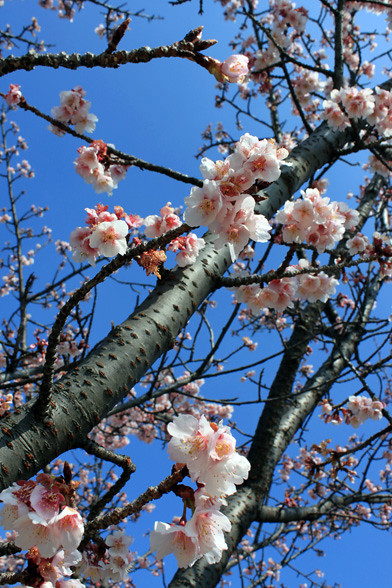The bus from Osaka emerged from the night into a concrete jungle of tall buildings, all shades of gray to match the gray skies overhead. Large droplets of slush rained down upon scenes from Shinjuku, a district in the western part of Greater Tokyo, that passed by outside of our fogged-up windows. Lara and Sam were still asleep when the bus driver announced we would be arriving at our stop, Tokyo Station, in thirty minutes. My eyes were dry and my brain felt like water sloshing sleepily inside my head but I felt surprisingly alert, pulling back the curtains and excitedly nudging my companions to look outside. By this time, we were passing what looked like a large moat and a garden enclosed by a stone wall beyond. The droplets of slush had now become small snowflakes that traced the footsteps of the wind and I realized that the garden beyond must be the Tokyo Imperial Palace, our first destination for the day.
The bus stopped briefly at Tokyo Station and I had little time between gathering my luggage and being left on the sidewalk of a random street in Tokyo to process what had just happened. We still had time before our tour of the Imperial Palace, so we took a quick look at the station and other adjoining underground malls. With fourteen subway, train, and high-speed rail lines, it was immediately obvious that this was a major transportation hub in the Tokyo area. Tokyo Station is normally a very beautiful looking building, a splash of color and traditional Western architecture amidst the surrounding sea of gray. However, during our stay, it was under renovation and guarded by white metal fencing and black netting.
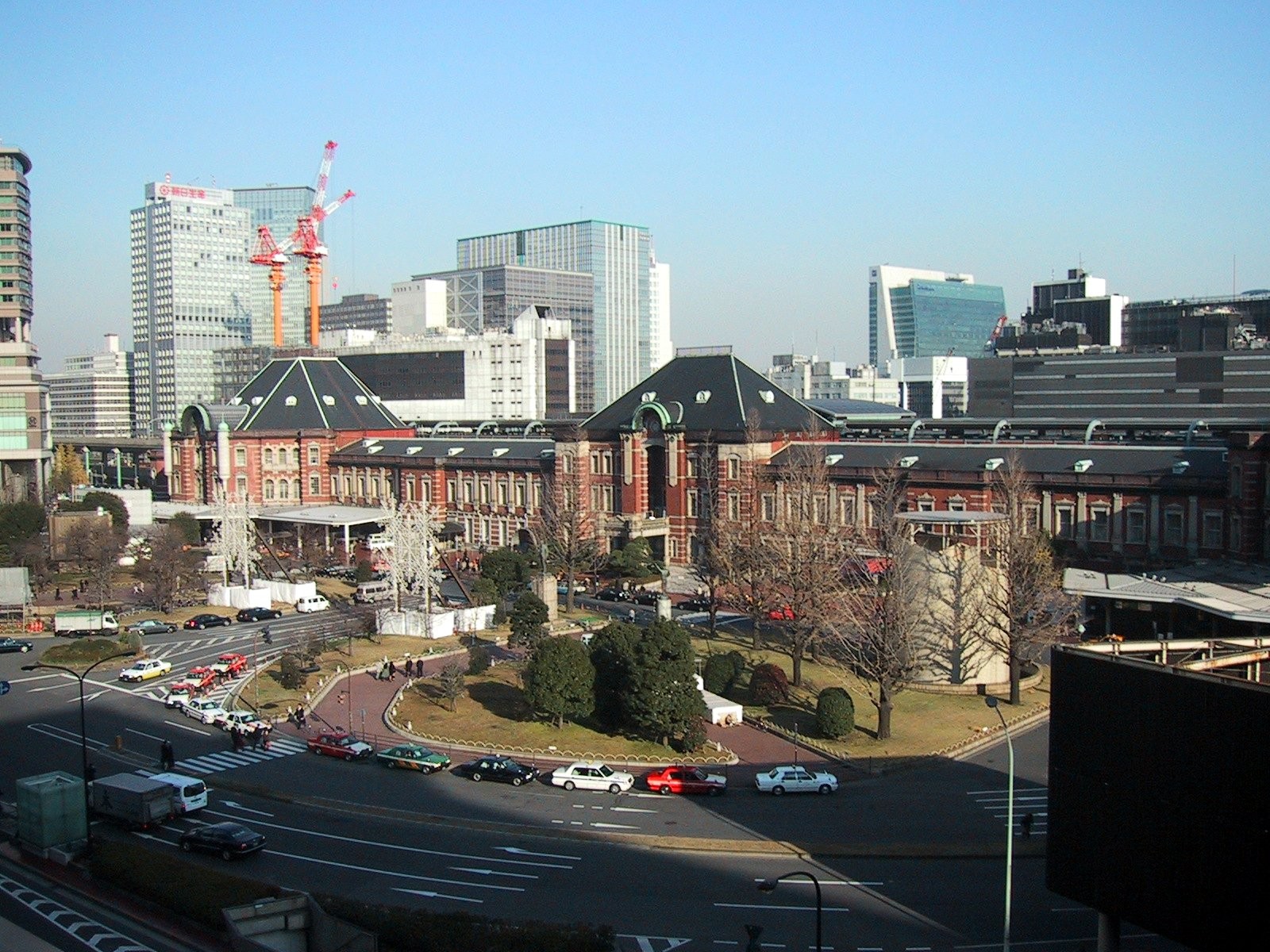 |
| Tokyo Station, Marunouchi side before renovation. (Image via Wikipedia). |
|
|
Nevertheless, we were able to spend quite some time seeing only a fraction of what the station had to offer and, after grabbing some breakfast at one of Japan's many incredible convenience stores, we headed out into the cold once more to meet with our tour guides.
Normally, I am opposed to guided tours because I prefer to enjoy the scenery and/or exhibits at my own pace. In the case of touring the Tokyo Imperial Palace, however, the Imperial Family still lives there, so regular people cannot enter the inner grounds without pre-arranging a guided tour (or unless during special occasions, such as the Emperor's birthday). We made it to the gate just in time and, after checking in with the guards, were led beyond a large iron and wooden gate to a building with a waiting room full of about fifty tourists. After a ten minute video detailing the palace's history and introducing the notable buildings, we were all herded toward the heart of the royal residence.
 |
An aerial view of the Palace grounds in the thick of the city,
surrounded on most sides by a moat. 1979. (Image via Wikipedia).
|
The Palace grounds are full of impressive rock walls made up of large, dark stones, each piece carved from a mountain by hand and carried over to the palace site during its original construction. Within these towering walls, there is a Japanese-style castle with white facades and dark roofs, the corners turning up to the heavens. Despite the crowd of people that accompanied us, the palace seemed quite serene in the morning air. It is located right in the thick of the modern and busy Chiyoda district, yet somehow maintains a regal and ancient atmosphere. All, that is, except for the very modern residence halls, designed with a blend of traditional and contemporary Japanese architecture.
 |
Stone walls, rounded bushes, and Fujimi Yagura (Mt. Fuji-View Keep),
within the inner grounds. |
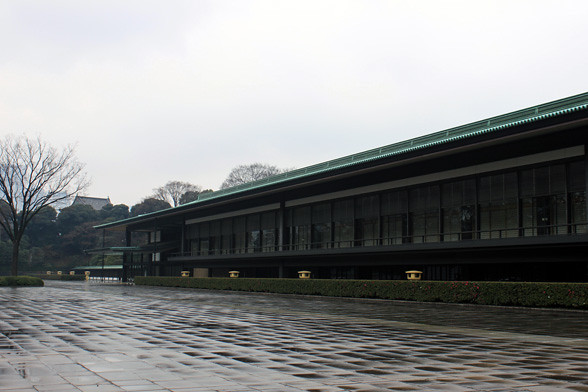 |
| Chowaden Reception Hall, the largest structure of the palace. Part of the Kyuden complex. On special occasion, the Emperor will address the public waiting in Kyuden Plaza from the balcony of this building. |
 |
| View of Chiyoda District, Tokyo from Nijubashi. |
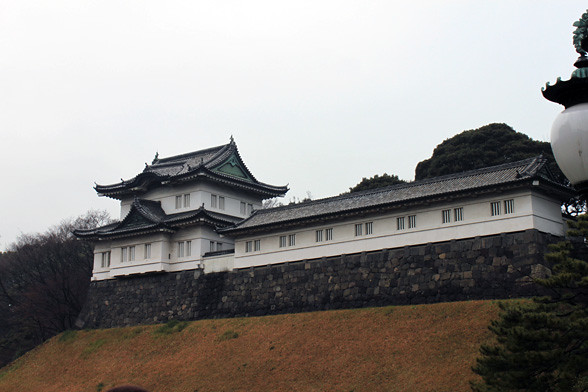 |
| Side view of another Fujimi Yagura. |
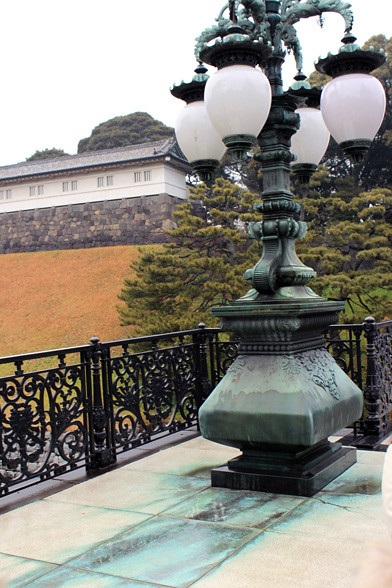 |
| The oxidization on a copper lamp stained the sidewalk a brilliant turquoise. |
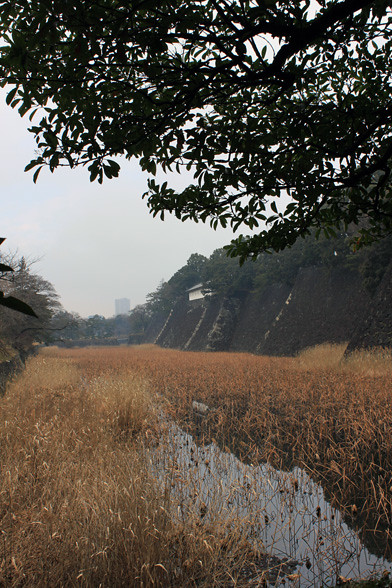 |
Hasuikebori lotus moat, just a marsh in the wintertime,
separating the outer wall from the inner wall. |
 |
| The palace even had its own gas station. |
After an hour had passed, the tour was over and we were all escorted back to the main gate. The three of us decided to continue onto the adjacent East Gardens (東御苑) and the Museum of the Imperial Collections (三の丸尚蔵館), areas of the Imperial Palace that are accessible to the public. By this time, the sun had emerged from the clouds and, although it was winter and many of the grounds' flowers had yet to bloom, the gardens still held an element of simple beauty. There were rather vast stretches of yellow grass fields, dark green pine trees, and the occasional splash of pale pink plum blossom.
One section of the gardens held a collection of small ponds and a small waterfall, guarded by venerable, brightly-colored carp. It was easy to see the reflection of traditional Japanese aesthetic in every detail of the garden's design. Before leaving the palace grounds, we climbed to the top of a rampart and looked out over the moat to the tall buildings and crowded streets beyond the palace grounds. It was a little hard to believe that all that green space and tranquility was just a stone's throw away from the busy metropolis.
 |
| Plum trees blossoming over a sea of golden yellow grass. |
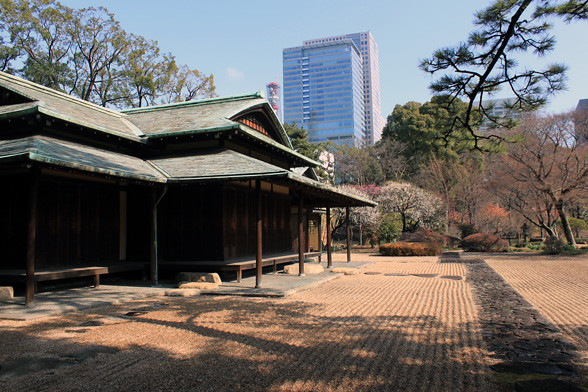 |
| Suwanochaya, an old teahouse in the gardens surrounded by carefully raked pebbles. Ninomaru Garden. |
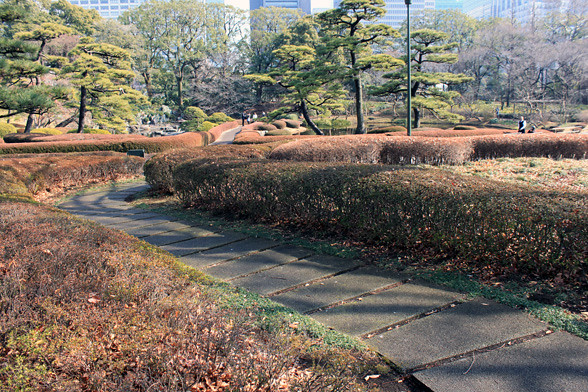 |
| A garden path leading to the pond area. Ninomaru Garden. |
 |
| Ninomaru Garden. |
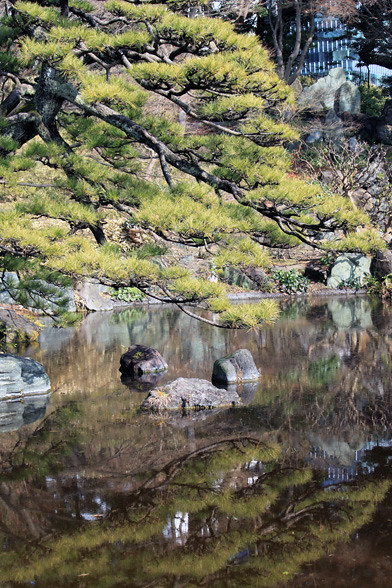 |
| Ninomaru Garden. |
 |
| A very large carp, one of the keepers of Ninomaru Garden. |
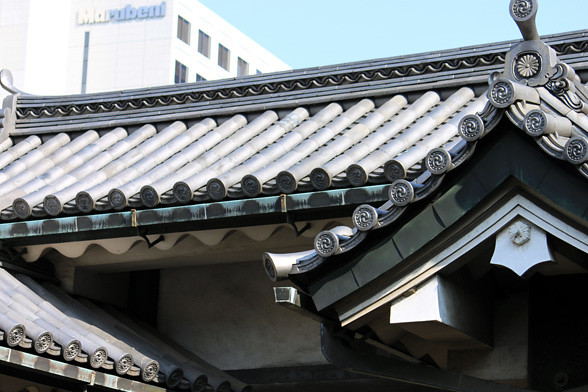 |
| Roof of the Hirokawa Gate with the Imperial Seal of Japan, "a sixteen-petal chrysanthemum with sixteen tips of another row of petals showing behind the first row". (Quote via Wikipedia). |
We exited the grounds from Hirokawa Gate to the north and, having only eaten some small snacks from a convenience store for breakfast, made a beeline to a restaurant just across the street featuring a macrobiotic, vegan perspective on Japanese food. The portion was small and expensive but that seems to be the story with most dining in Tokyo, especially true for vegetarian food. Nevertheless, the bowl of soup, cup of noodles, mound of rice, and tempeh slices were perfectly filling.
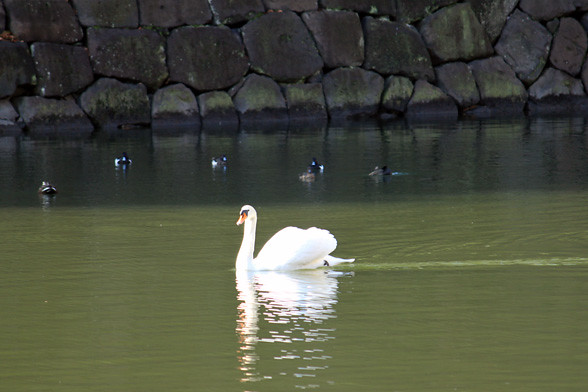 |
| The outer moat of the Imperial Palace grounds. |
From this point, we were originally planning on checking into our hotel and then making our way to Akihabara (秋葉原), the electronics district of Tokyo. However, after the rough night on the bus, we decided a nap was in order. We zombie-walked to the subway station and, after a surprisingly simple introduction to Tokyo's intimidating subway system, soon arrived at our place of stay for the next five nights. The late afternoon sun painted the neighborhood in warm hues of orange and red; it was nice to stay in a place tucked away from all the rush of the main metropolis. While still a far-cry from the tranquility of the countryside, it was still nice to see people carrying out the tasks of their daily lives: mothers walking and laughing with their small children, mechanics toiling over a broken-down car, and older people strolling home with a bag of groceries. I enjoyed the slice of life feel to the area, albeit limited from our tourist perspective.
After checking in, we further decided that it would be best to visit Akihabara the next day instead and, settling in to our home in Tokyo, we quickly fell asleep and remained that way until the following dawn promised another day of beautiful sunshine and adventure.

















